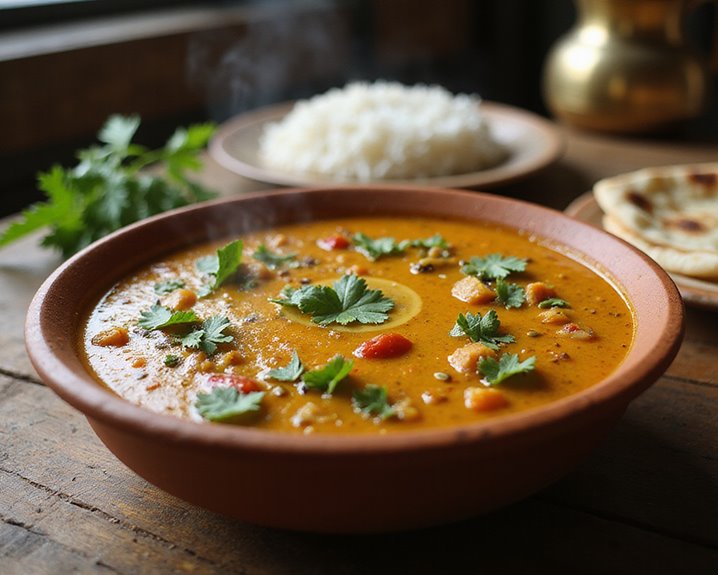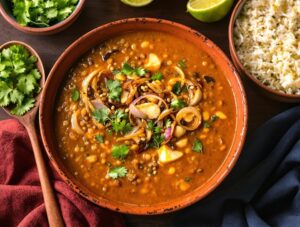Why You’ll Love this Authentic Indian Dal
Once you taste this authentic Indian dal, you’ll understand why it’s a staple in countless households across India. It’s comfort food at its finest—warming, deeply aromatic, and surprisingly simple to prepare in your own kitchen.
The combination of split red gram (masoor dal) with those fragrant spices creates magic in your mouth. Who can resist that perfect balance of turmeric, cumin, and garam masala? The texture is velvety yet substantial, perfect for scooping up with naan or spooning over rice.
What I love most is how adaptable this recipe is. Need it spicier? Add another green chili. Prefer it thicker? Simply simmer a bit longer. It’s also incredibly economical—proving that the most satisfying dishes don’t require fancy ingredients.
What Ingredients are in Authentic Indian Dal?
Indian dal is a comforting, protein-rich dish that forms the backbone of many Indian meals. This authentic recipe uses split red gram (also known as masoor dal) as its base and builds layers of flavor through a variety of aromatic spices and fresh ingredients.
The combination of onions, tomatoes, garlic, and ginger creates a deeply satisfying base, while the tempering with cumin and mustard seeds adds that distinctive Indian flavor profile.
- 1 cup split red gram (dal), soaked in 3 cups water
- 1 large onion, sliced (plus another half onion for later)
- 1 large tomato, chopped (plus another small tomato for later)
- 5 cloves garlic, chopped (divided)
- 1/2 inch gingerroot, peeled and minced
- 2 green chilies, deseeded and slit
- 1/4 teaspoon turmeric powder
- 1/4 teaspoon salt
- 1 1/2 tablespoons oil (divided)
- 1 pinch asafoetida powder
- 2/3 teaspoon mustard seeds
- 1/2 teaspoon cumin seeds
- 2 sprigs curry leaves
- 1 chicken or vegetable stock cube
- 1/4 teaspoon chili powder
- 1/4 teaspoon garam masala powder
- 1/4 teaspoon cumin powder
- 1/4 teaspoon coriander powder
- 3 tablespoons chopped coriander leaves (cilantro) for garnish
- 2 teaspoons lime juice
When shopping for these ingredients, you might notice some variations in what’s available. Split red gram is sometimes labeled as masoor dal in grocery stores, and asafoetida (hing) might be found in the international aisle or at specialty Indian markets. Fresh curry leaves make a big difference in flavor, but if you can’t find them, you can substitute with dried leaves or omit them. The beauty of dal is its flexibility—you can adjust the spice levels to suit your taste preferences and still create an authentic, delicious meal.
How to Make this Authentic Indian Dal

To prepare this flavorful dal, start by washing 1 cup of split red gram and soaking it in 3 cups of water for an hour. Transfer the soaked dal along with its water into a pressure cooker or cooking vessel, adding 1 sliced onion, 1 big chopped tomato, 3 chopped garlic cloves, and 1/2 inch of minced ginger. Toss in 2 deseeded green chilies, 1/4 teaspoon of turmeric powder, 1/4 teaspoon of salt, and 1/2 teaspoon of oil. Cook until the dal is tender—if using a pressure cooker, it typically takes just one whistle.
While the dal cooks, gather and prepare your remaining ingredients for the tempering, which is what gives this dish its authentic touch. Having an Indian cooking appliance set on hand makes preparing authentic dishes like this much easier and more convenient.
Once the dal is cooked through, it’s time for the tempering, or as it’s traditionally known, tadka. Heat 1 tablespoon of oil in a separate pan and add a pinch of asafoetida powder (this gives that distinctive umami flavor), 2/3 teaspoon of mustard seeds, and 1/2 teaspoon of cumin seeds. When the seeds begin to splutter—such a satisfying sound, isn’t it?—add 2 sprigs of curry leaves, 1/2 a sliced onion, and 2 minced garlic cloves. Sauté until the onions turn translucent, then add 1 small chopped tomato along with the spice powders: 1/4 teaspoon each of chili powder, garam masala, cumin powder, and coriander powder. Crumble in a chicken or vegetable stock cube for depth, then pour this aromatic mixture into the cooked dal. Finish with 2 teaspoons of lime juice and a generous garnish of 3 tablespoons of chopped coriander leaves. The result? A dal that’s both comforting and complex, ready to be served with rice or flatbread.
Authentic Indian Dal Substitutions and Variations
While the traditional recipe creates a spectacular flavor profile, you’ll be happy to know that dal is incredibly forgiving and adaptable to what’s in your pantry. No red lentils? Yellow moong dal or toor dal work beautifully as substitutes. Can’t find asafoetida? Simply omit it or use a pinch of garlic powder instead.
For a richer version, I’d suggest adding a dollop of ghee (clarified butter) at the end. Vegetarians can swap the chicken stock cube for vegetable stock or plain water with extra spices. Want it creamier? A splash of coconut milk transforms this humble dish into something luxurious.
The spice level is entirely up to you. Reduce the chili powder for milder palates, or amp it up with extra green chilies for heat lovers.
What to Serve with Authentic Indian Dal
Every satisfying bowl of dal deserves perfect companions to create a complete Indian meal experience. I always recommend fluffy basmati rice as the traditional foundation—nothing beats how it soaks up those rich, spiced lentils.
Warm roti or naan, straight from the pan, makes for ideal scooping vessels, catching every last drop of that golden goodness.
For sides, try a cooling cucumber raita to balance the spices, or quick-pickled onions for tangy contrast. A simple vegetable dish like aloo gobi (potato and cauliflower) or baingan bharta (smoky eggplant) rounds things out nicely.
Can’t forget a sprinkle of fresh cilantro and a squeeze of lime right before serving—these bright finishers tie everything together, transforming your humble dal into a proper feast.
Final Thoughts
Making authentic Indian dal has become one of my favorite kitchen rituals, not just for its incredible flavor but for the way it connects us to centuries of culinary tradition. There’s something deeply satisfying about transforming humble lentils into a dish that’s both nourishing and complex.
What I love most about dal is its versatility. You can adjust the spices to suit your taste, make it as thick or thin as you prefer, or add vegetables for extra nutrition. It’s forgiving that way, perfect for both novice cooks and seasoned chefs.

